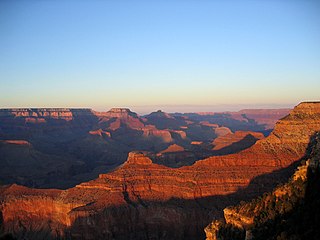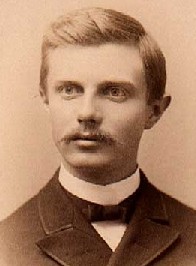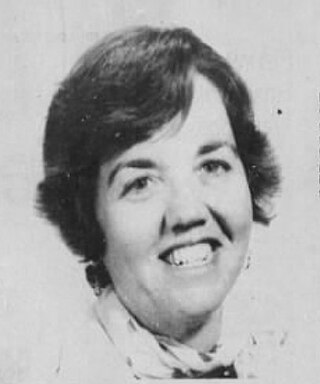
The Southwestern United States, also known as the American Southwest or simply the Southwest, is a geographic and cultural region of the United States that includes Arizona and New Mexico, along with adjacent portions of California, Colorado, Nevada, Oklahoma, Texas, and Utah. The largest cities by metropolitan area are Phoenix, Las Vegas, El Paso, Albuquerque, and Tucson. Before 1848, in the historical region of Santa Fe de Nuevo México as well as parts of Alta California and Coahuila y Tejas, settlement was almost non-existent outside of Nuevo México's Pueblos and Spanish or Mexican municipalities. Much of the area had been a part of New Spain and Mexico until the United States acquired the area through the Treaty of Guadalupe Hidalgo in 1848 and the smaller Gadsden Purchase in 1854.

The Western United States, also called the American West, the Western States, the Far West, the Western territories, and the West, is the region comprising the westernmost U.S. states. As American settlement in the U.S. expanded westward, the meaning of the term the West changed. Before around 1800, the crest of the Appalachian Mountains was seen as the western frontier. The frontier moved westward and eventually the lands west of the Mississippi River were considered the West.

Frederick Jackson Turner was an American historian during the early 20th century, based at the University of Wisconsin-Madison until 1910, and then Harvard University. He was known primarily for his frontier thesis. He trained many PhDs who went on to become well-known historians. He promoted interdisciplinary and quantitative methods, often with an emphasis on the Midwestern United States.
The Western History Association (WHA), a 501(c)(3) non-profit organization, was founded in 1961 at Santa Fe, New Mexico by Ray Allen Billington, et al. Included in the field of study are the American West and western Canada. The Western History Association was headquartered from 2012 to 2017 at the University of Alaska, Fairbanks. From 2018 to 2020 the WHA was hosted on the campus of the University of Nebraska at Omaha. In 2020, the WHA relocated to the Department of History at the University of Kansas, where it receives support from the College of Liberal Arts and Sciences.

Morris Edward Opler, American anthropologist and advocate of Japanese American civil rights, was born in Buffalo, New York. He was the brother of Marvin Opler, an anthropologist and social psychiatrist.
Walter Prescott Webb was an American historian noted for his groundbreaking work on the American West. As president of the Texas State Historical Association, he launched the project that produced the Handbook of Texas. He is a member of the Hall of Great Westerners, which is a part of the National Cowboy & Western Heritage Museum.
Native American studies is an interdisciplinary academic field that examines the history, culture, politics, issues, spirituality, sociology and contemporary experience of Native peoples in North America, or, taking a hemispheric approach, the Americas. Increasingly, debate has focused on the differences rather than the similarities between other ethnic studies disciplines such as African American studies, Asian American studies, and Latino/a studies.

The history of Arizona encompasses the Paleo-Indian, Archaic, Post-Archaic, Spanish, Mexican, and American periods. About 10,000 to 12,000 years ago, Paleo-Indians settled in what is now Arizona. A few thousand years ago, the Ancestral Puebloan, the Hohokam, the Mogollon and the Sinagua cultures inhabited the state. However, all of these civilizations mysteriously disappeared from the region in the 15th and 16th centuries. Today, countless ancient ruins can be found in Arizona. Arizona was part of the state of Sonora, Mexico from 1822, but the settled population was small. In 1848, under the terms of the Mexican Cession the United States took possession of Arizona above the Gila River after the Mexican War, and became part of the Territory of New Mexico. By means of the Gadsden Purchase, the United States secured the northern part of the state of Sonora, which is now Arizona south of the Gila River in 1854.

The Spanish missions in the Sonoran Desert are a series of Jesuit Catholic religious outposts established by the Spanish Catholic Jesuits and other orders for religious conversions of the Pima and Tohono O'odham indigenous peoples residing in the Sonoran Desert. An added goal was giving Spain a colonial presence in their frontier territory of the Sonora y Sinaloa Province in the Viceroyalty of New Spain, and relocating by Indian Reductions settlements and encomiendas for agricultural, ranching, and mining labor.
Stephen Plog is an American archaeologist and anthropologist, who specializes in the pre-Columbian cultures of the American Southwest. As the Commonwealth Professor of Anthropology at The University of Virginia, he currently teaches undergraduate and graduate students, and is working to digitize all the research on the Chaco Canyon through the Chaco Research Archive. On May 1, 2006 he was elected to the National Academy of Sciences. Election to the academy is among the highest distinctions for a scientist, and is based on outstanding and ongoing achievements in original research. He was also a visiting fellow at the School of American Research in Santa Fe, New Mexico in 2001-2002.

Chicano studies, also known as Chicano/a studies, Chican@ studies, or Xicano studies originates from the Chicano Movement of the late 1960s and 1970s, and is the study of the Chicano and Latino experience. Chicano studies draws upon a variety of fields, including history, sociology, the arts, and Chicano literature. The area of studies additionally emphasizes the importance of Chicano educational materials taught by Chicano educators for Chicano students.
The Sobaipuri were one of many indigenous groups occupying Sonora and what is now Arizona at the time Europeans first entered the American Southwest. They were a Piman or O'odham group who occupied southern Arizona and northern Sonora in the 15th–19th centuries. They were a subgroup of the O'odham or Pima, surviving members of which include the residents of San Xavier del Bac which is now part of the Tohono O'odham Nation and the Akimel O'odham.
Vance T. Holliday is a professor in the School of Anthropology and the department of Geosciences as well as an adjunct professor in the department of Geography at the University of Arizona in Tucson.
This is a Mexican American bibliography. This list consists of books, and journal articles, about Mexican Americans, Chicanos, and their history and culture. The list includes works of literature whose subject matter is significantly about Mexican Americans and the Chicano/a experience. This list does not include works by Mexican American writers which do not address the topic, such as science texts by Mexican American writers.
Clara Lee Tanner was an American anthropologist, editor and art historian. She is known for studies of the arts and crafts of American Indians of the Southwest.
Thomas E. Sheridan is an anthropologist of Sonora, Mexico and the history and culture of Arizona and the Southwest. He was selected a Distinguished Outreach Professor at the University of Arizona, and has been affiliated with the Department of Anthropology and the Southwest Center since 2003.
John Alexander Carroll was an American academic between the 1950s to 1980s. During this time period, he primarily worked for the University of Arizona and Troy State University. While with Arizona, Carroll created Arizona and the West in 1959. He remained as the journal's editor until 1963.
Barbara Ann Babcock was an American folklore scholar, professor of Comparative Cultural and Literary Studies, Women's Studies, and American Indian Studies at the University of Arizona.

Myra Dinnerstein was the founding director of the women's studies program at the University of Arizona. After completing an undergraduate degree at the University of Pennsylvania and a doctorate at Columbia University, she began teaching at the University of Arizona. In 1975, she started the women's studies program as an academic minor, and grew it into a full department with accredited undergraduate and master's degrees. She successfully fought an attempt to remove the program launched by the Arizona State Legislature because lesbian history and achievements were included in the curriculum. She retired in 2003 and was honored in 2005 the Women's Plaza of Honor.
Bibliography of the Western United States is a small selection of the most useful books and articles on the Western United States.








